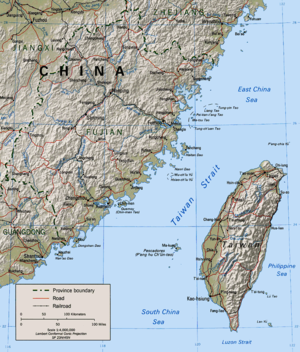|
Wade–Giles
 Wade–Giles (/weɪd dʒaɪlz/ wayd jylze) is a romanization system for Mandarin Chinese. It developed from the system produced by Thomas Francis Wade during the mid-19th century, and was given completed form with Herbert Giles's A Chinese–English Dictionary (1892). The romanization systems in common use until the late 19th century were based on the Nanjing dialect, but Wade–Giles was based on the Beijing dialect and was the system of transcription familiar in the English-speaking world for most of the 20th century. Both of these kinds of transcription were used in postal romanizations (romanized place-names standardized for postal uses). In mainland China, Wade–Giles has been mostly replaced by Hanyu Pinyin, which was officially adopted in 1958, with exceptions for the romanized forms of some of the most commonly used names of locations and persons, and other proper nouns. The romanized name for most locations, persons and other proper nouns in Taiwan is based on the Wade–Giles derived romanized form, for example Kaohsiung, the Matsu Islands and Chiang Ching-kuo. HistoryWade–Giles was developed by Thomas Francis Wade, a scholar of Chinese and a British ambassador in China who was the first professor of Chinese at the University of Cambridge. Wade published Yü-yen Tzŭ-erh Chi (語言自邇集; 语言自迩集)[2] in 1867, the first textbook on the Beijing dialect of Mandarin in English,[3] which became the basis for the system later known as Wade–Giles. The system, designed to transcribe Chinese terms for Chinese specialists, was further refined in 1892 by Herbert Giles (in A Chinese–English Dictionary), a British diplomat in China, and his son Lionel Giles,[citation needed] a curator at the British Museum.[4] Taiwan used Wade–Giles for decades as the de facto standard, co-existing with several official romanizations in succession, namely, Gwoyeu Romatzyh (1928), Mandarin Phonetic Symbols II (1986), and Tongyong Pinyin (2000). The Kuomintang (KMT) has previously promoted pinyin with Ma Ying-jeou's successful presidential bid in 2008 and in a number of cities with Kuomintang mayors.[citation needed]However, the Tsai Ing-wen administration and Democratic Progressive Party (DPP) along with the majority of the people in Taiwan, both native and overseas, use spelling and transcribe their legal names based on the Wade–Giles system, as well as the other aforementioned systems.[citation needed] Initials and finalsThe tables below show the Wade–Giles representation of each Chinese sound (in bold type),[5] together with the corresponding IPA phonetic symbol (in square brackets), and equivalent representations in Bopomofo and Hanyu Pinyin. Initials
Instead of ts, tsʻ and s, Wade–Giles writes tz, tzʻ and ss before ŭ (see below). FinalsWade–Giles writes -uei after kʻ and k, otherwise -ui: kʻuei, kuei, hui, shui, chʻui. It writes [-ɤ] as -o after kʻ, k and h, otherwise as -ê: kʻo, ko, ho, shê, chʻê. When [ɤ] forms a syllable on its own, it is written ê or o depending on the character. Wade–Giles writes [-wo] as -uo after kʻ, k, h and sh, otherwise as -o: kʻuo, kuo, huo, shuo, bo, tso. After chʻ, it is written chʻo or chʻuo depending on the character. For -ih and -ŭ, see below. Giles's A Chinese–English Dictionary also includes the finals -io (in yo, chio, chʻio, hsio, lio and nio) and -üo (in chüo, chʻüo, hsüo, lüo and nüo), both of which are pronounced -üeh in modern Standard Chinese: yüeh, chüeh, chʻüeh, hsüeh, lüeh and nüeh. Syllables that begin with a medial
Wade–Giles writes the syllable [i] as i or yi depending on the character. System featuresConsonants and initial symbolsA feature of the Wade–Giles system is the representation of the unaspirated-aspirated stop consonant pairs using a character resembling an apostrophe. Thomas Wade and others used the spiritus asper (ʽ or ʻ), borrowed from the polytonic orthography of the Ancient Greek language. Herbert Giles and others used a left (opening) curved single quotation mark (‘) for the same purpose. A third group used a plain apostrophe ('). The backtick, and visually similar characters, are sometimes seen in various electronic documents using the system. Examples using the spiritus asper: p, pʻ, t, tʻ, k, kʻ, ch, chʻ. The use of this character preserves b, d, g, and j for the romanization of Chinese varieties containing voiced consonants, such as Shanghainese (which has a full set of voiced consonants) and Min Nan (Hō-ló-oē) whose century-old Pe̍h-ōe-jī (POJ, often called Missionary Romanization) is similar to Wade–Giles. POJ, Legge romanization, Simplified Wade, and EFEO Chinese transcription use the letter ⟨h⟩ instead of an apostrophe-like character to indicate aspiration. (This is similar to the obsolete IPA convention before the revisions of the 1970s). The convention of an apostrophe-like character or ⟨h⟩ to denote aspiration is also found in romanizations of other Asian languages, such as McCune–Reischauer for Korean and ISO 11940 for Thai. People unfamiliar with Wade–Giles often ignore the spiritus asper, sometimes omitting them when copying texts, unaware that they represent vital information. Hànyǔ Pīnyīn addresses this issue by employing the Latin letters customarily used for voiced stops, unneeded in Mandarin, to represent the unaspirated stops: b, p, d, t, g, k, j, q, zh, ch. Partly because of the popular omission of apostrophe-like characters, the four sounds represented in Hànyǔ Pīnyīn by j, q, zh, and ch often all become ch, including in many proper names. However, if the apostrophe-like characters are kept, the system reveals a symmetry that leaves no overlap:
Vowels and final symbolsSyllabic consonantsLike Yale and Mandarin Phonetic Symbols II, Wade–Giles renders the two types of syllabic consonant (simplified Chinese: 空韵; traditional Chinese: 空韻; Wade–Giles: kʻung1-yün4; Hànyǔ Pīnyīn: kōngyùn) differently:
These finals are both written as -ih in Tongyòng Pinyin, as -i in Hànyǔ Pīnyīn (hence distinguishable only by the initial from [i] as in li), and as -y in Gwoyeu Romatzyh and Simplified Wade. They are typically omitted in Zhùyīn (Bōpōmōfō).
Vowel oFinal o in Wade–Giles has two pronunciations in modern Peking dialect: [wo] and [ɤ]. What is pronounced in vernacular Peking dialect as a close-mid back unrounded vowel [ɤ] is written usually as ê, but sometimes as o, depending on historical pronunciation (at the time Wade–Giles was developed). Specifically, after velar initials k, kʻ and h (and a historical ng, which had been dropped by the time Wade–Giles was developed), o is used; for example, "哥" is ko1 (Pīnyīn gē) and "刻" is kʻo4[6] (Pīnyīn kè). In Peking dialect, o after velars (and what used to be ng) have shifted to [ɤ], thus they are written as ge, ke, he and e in Pīnyīn. When [ɤ] forms a syllable on its own, Wade–Giles writes ê or o depending on the character. In all other circumstances, it writes ê. What is pronounced in Peking dialect as [wo] is usually written as o in Wade–Giles, except for wo, shuo (e.g. "說" shuo1) and the three syllables of kuo, kʻuo, and huo (as in 過, 霍, etc.), which contrast with ko, kʻo, and ho that correspond to Pīnyīn ge, ke, and he. This is because characters like 羅, 多, etc. (Wade–Giles: lo2, to1; Pīnyīn: luó, duō) did not originally carry the medial [w]. Peking dialect does not have phonemic contrast between o and -uo/wo (except in interjections when used alone) and a medial [w] is usually inserted in front of -o to form [wo].
Zhùyīn and Pīnyīn write [wo] as ㄛ -o after ㄅ b, ㄆ p, ㄇ m and ㄈ f, and as ㄨㄛ -uo after all other initials. TonesTones are indicated in Wade–Giles using superscript numbers (1–4) placed after the syllable. This contrasts with the use of diacritics to represent the tones in Pīnyīn. For example, the Pīnyīn qiàn (fourth tone) has the Wade–Giles equivalent chʻien4.
PunctuationWade–Giles uses hyphens to separate all syllables within a word (whereas Pīnyīn separates syllables only in specially defined cases, using hyphens or closing (right) single quotation marks as appropriate). If a syllable is not the first in a word, its first letter is not capitalized, even if it is part of a proper noun. The use of apostrophe-like characters, hyphens, and capitalization is frequently not observed in place names and personal names. For example, the majority of overseas Taiwanese people write their given names like "Tai Lun" or "Tai-Lun", whereas the Wade–Giles is actually "Tai-lun". (See also Chinese names.) Comparison with other systemsPinyin
Chart
Note: In Hànyǔ Pīnyīn, the so-called neutral tone is written leaving the syllable with no diacritic mark at all. In Tongyòng Pinyin, a ring is written over the vowel. AdaptationsThere are several adaptations of Wade–Giles. MathewsThe Romanization system used in the 1943 edition of Mathews' Chinese–English Dictionary differs from Wade–Giles in the following ways:[7]
TableGalleryExamples of Wade–Giles derived English language terminology:
See also
References
Bibliography
Further reading
External linksWikimedia Commons has media related to Wade–Giles. Look up Wade–Giles or Category:English terms derived from Wade–Giles in Wiktionary, the free dictionary.
|
|||||||||||||||||||||||||||||||||||||||||||||||||||||||||||||||||||||||||||||||||||||||||||||||||||||||||||||||||||||||||||||||||||||||||||||||||||||||||||||||||||||||||||||||||||||||||||||||||||||||||||||||||||||||||||||||||||||||||||||||||||||||||||||||||||||||||||||||||||||||||||||||||||||||||||||||||||||||||||||||||||||||||||||||||||||||||||||||||||||||||||||||||||||||||||||||||||||||||||||||||||||||||||||||||||||||||||||||||||||||||||||||||||||||||||||||||||||||||||||||||||||||||||||||||||||||||||||||||||||||||||||||||||||||||||||||||||||||||||||||||||||||||||||||||||||||||||||||||||||||||||||||||||||||||||||||||||||||||||||||||||||||||||||||||||||||||||||||||||||||||||||||||||||||||||||||||||||||||||||||||



